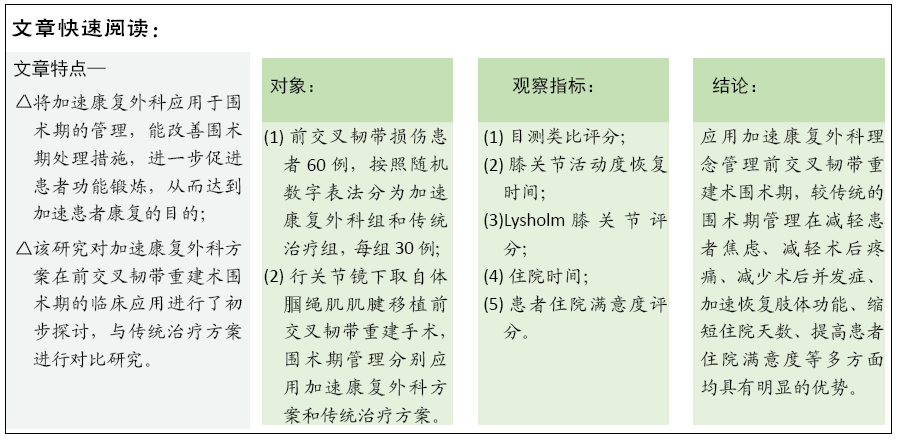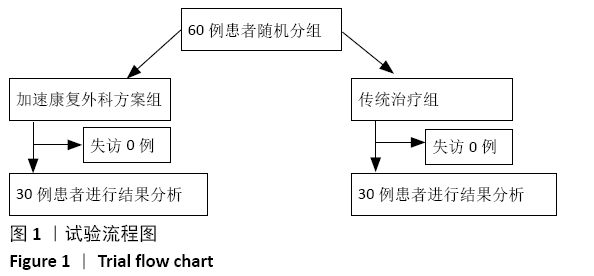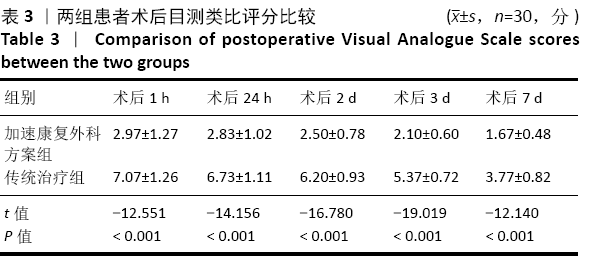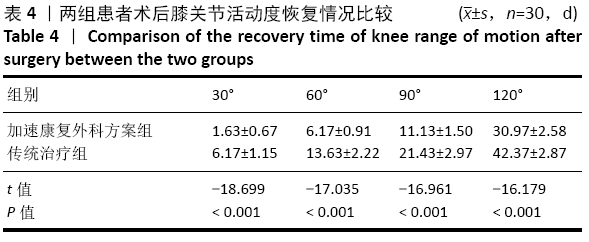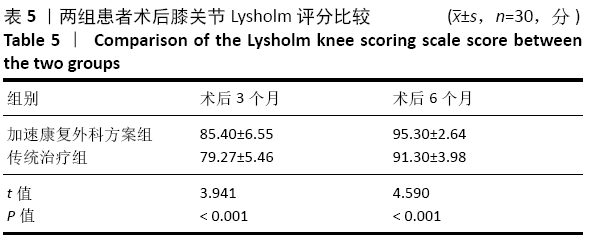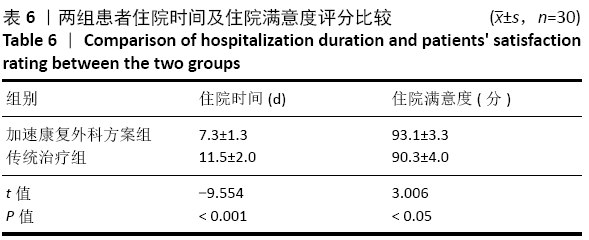[1] MICHALITSIS S, VLYCHOU M, MALIZOS KN, et al. Meniscal and articular cartilage lesions in the anterior cruciate ligament-deficient knee: correlation between time from injury and knee scores. Knee Surg Sports Traumatol Arthrosc. 2015;23(1):232-239.
[2] JÄRVELÄ S, KIEKARA T, SUOMALAINEN P, et al. Double-Bundle Versus Single-Bundle Anterior Cruciate Ligament Reconstruction: A Prospective Randomized Study With 10-Year Results. Am J Sports Med. 2017;45(11): 2578-2585.
[3] MUELLER LM, BLOOMER BA, DURALL CJ. Which outcome measures should be utilized to determine readiness to play after ACL reconstruction? J Sport Rehabil. 2014;23(2):158-164.
[4] ZHANG S, HUANG Q, XIE J, et al. Factors influencing postoperative length of stay in an enhanced recovery after surgery program for primary total knee arthroplasty. J Orthop Surg Res. 2018;13(1):29.
[5] LJUNGQVIST O, SCOTT M, FEARON KC. Enhanced Recovery After Surgery: A Review. JAMA Surg. 2017;152(3):292-298.
[6] BASSE L, RASKOV HH, HJORT JAKOBSEN D, et al. Accelerated postoperative recovery programme after colonic resection improves physical performance, pulmonary function and body composition. Br J Surg. 2002;89(4):446-453.
[7] GWYNNE-JONES DP, MARTIN G, CRANE C. Enhanced Recovery After Surgery for Hip and Knee Replacements. Orthop Nurs. 2017;36(3):203-210.
[8] STOWERS MD, MUNRO JT, HILL AG. Enhanced Recovery After Surgery in elective total arthroplasty: the new standard of perioperative care. ANZ J Surg. 2016;86(5):327-328.
[9] KEHLET H, WILMORE DW. Multimodal strategies to improve surgical outcome. Am J Surg. 2002;183(6):630-641.
[10] MORTENSEN K, NILSSON M, SLIM K, et al. Consensus guidelines for enhanced recovery after gastrectomy: Enhanced Recovery After Surgery (ERAS®) Society recommendations. Br J Surg. 2014;101(10):1209-1229.
[11] WAINWRIGHT TW, IMMINS T, MIDDLETON RG. Enhanced recovery after surgery (ERAS) and its applicability for major spine surgery. Best Pract Res Clin Anaesthesiol. 2016;30(1):91-102.
[12] SCOTT NB, MCDONALD D, CAMPBELL J, et al. The use of enhanced recovery after surgery (ERAS) principles in Scottish orthopaedic units--an implementation and follow-up at 1 year, 2010-2011: a report from the Musculoskeletal Audit, Scotland. Arch Orthop Trauma Surg. 2013; 133(1):117-124.
[13] SCHMIDT CR. Enhanced recovery after surgery-Summary recommendations. J Surg Oncol. 2017;116(5):638.
[14] MITCHELL M. The future of surgical nursing and enhanced recovery programmes. Br J Nurs. 2011;20(16):978-984.
[15] MCDONALD S, PAGE MJ, BERINGER K, et al. Preoperative education for hip or knee replacement. Cochrane Database Syst Rev. 2014;2014(5):CD003526.
[16] MANCUSO CA, REID MC, DUCULAN R, et al. Improvement in Pain After Lumbar Spine Surgery: The Role of Preoperative Expectations of Pain Relief. Clin J Pain. 2017;33(2):93-98.
[17] SMITH MD, MCCALL J, PLANK L, et al. Preoperative carbohydrate treatment for enhancing recovery after elective surgery. Cochrane Database Syst Rev. 2014;(8):CD009161.
[18] PHILLIPS WJ, CURRIER BL. Analgesic pharmacology: I. Neurophysiology. J Am Acad Orthop Surg. 2004;12(4):213-220.
[19] FERNANDEZ M, COLODRO-CONDE L, HARTVIGSEN J, et al. Chronic low back pain and the risk of depression or anxiety symptoms: insights from a longitudinal twin study. Spine J. 2017;17(7):905-912.
[20] AUYONG DB, ALLEN CJ, PAHANG JA, et al. Reduced Length of Hospitalization in Primary Total Knee Arthroplasty Patients Using an Updated Enhanced Recovery After Orthopedic Surgery (ERAS) Pathway. J Arthroplasty. 2015; 30(10):1705-1709.
[21] PARVIZI J, MILLER AG, GANDHI K. Multimodal pain management after total joint arthroplasty. J Bone Joint Surg Am. 2011;93(11):1075-1084.
[22] MARDANI-KIVI M, KARIMI MOBARAKEH M, HAGHIGHI M, et al. Celecoxib as a pre-emptive analgesia after arthroscopic knee surgery; a triple-blinded randomized controlled trial. Arch Orthop Trauma Surg. 2013;133(11): 1561-1566.
[23] KIM MK, MOON HY, RYU CG, et al. The analgesic efficacy of the continuous adductor canal block compared to continuous intravenous fentanyl infusion with a single-shot adductor canal block in total knee arthroplasty: a randomized controlled trial. Korean J Pain. 2019;32(1):30-38.
[24] POGATZKI-ZAHN EM, SCHNABEL A, Zahn PK. Room for improvement: unmet needs in postoperative pain management. Expert Rev Neurother. 2012;12(5):587-600.
[25] BASQUES BA, TOY JO, BOHL DD, et al. General compared with spinal anesthesia for total hip arthroplasty. J Bone Joint Surg Am. 2015;97(6): 455-461.
[26] 吴新民,罗爱伦,田玉科,等.术后恶心呕吐防治专家意见(2012)[J].临床麻醉学杂志,2012,28(4):413-416.
[27] DIFRONZO LA, YAMIN N, PATEL K, et al. Benefits of early feeding and early hospital discharge in elderly patients undergoing open colon resection. J Am Coll Surg. 2003;197(5):747-752.
[28] AASVANG EK, LUNN TH, HANSEN TB, et al. Chronic pre-operative opioid use and acute pain after fast-track total knee arthroplasty. Acta Anaesthesiol Scand. 2016;60(4):529-536.
[29] RADAUCEANU DS, DRAGNEA D, CRAIG J. NICE guidelines for inadvertent peri-operative hypothermia. Anaesthesia. 2009;64(12):1381-1382.
|
